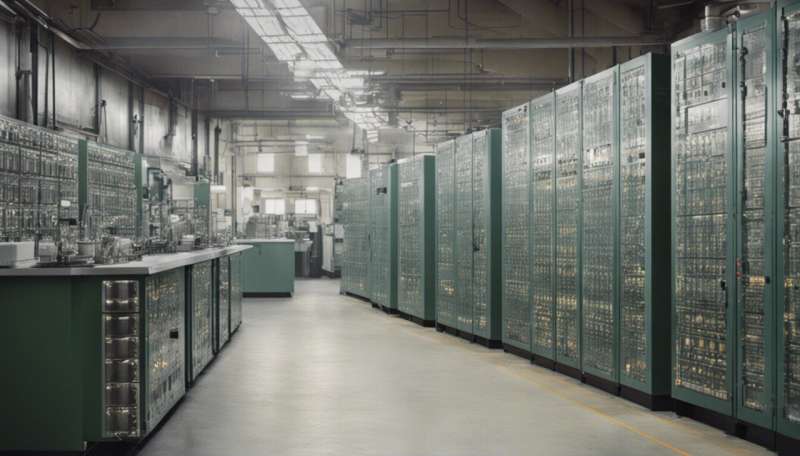Credit: AI-generated image (disclaimer)
India is one of only a few countries whose national emissions reduction target is in line with the Paris Agreement's goal of reducing global warming before Earth's temperature reaches a dangerous threshold. But to successfully switch from coal to renewable energy, the country will require advanced battery technologies that can operate even when solar and wind are not available.
India could achieve this by buying billions of dollars' worth of batteries abroad. But a new analysis by Stanford University researchers indicates that, with some government assistance, the world's second most populous country could also develop its own battery industry—and become a global power broker in the process.
In a new study, published in the December issue of Journal of Energy Storage, the researchers recommend that India focus on battery manufacturing in the short term but build capacity for higher-value research and development for the long term. In addition, the government should help identify target markets and potentially explore the use of protectionist measures that give domestic companies an advantage over international competitors, according to the study authors, who are affiliated with the Sustainable Finance Initiative at Stanford's Precourt Institute for Energy.
"All of our successful case studies show some form of government intervention to help ensure success," said Aravind Retna Kumar, co-author of the study. "These were most often aimed at giving local manufacturers a competitive advantage over international competitors."
Achieving ambitious decarbonization
By 2030, India plans to generate 40 percent of its electricity from renewable sources and have electric vehicles make up 30 percent of its automobile sales.
"These are aggressive targets," said Gireesh Shrimali, co-author of the work. "We expect that this will drive significant demand for battery storage in India."
Recognizing that batteries could be key to meeting its decarbonization goals, India's government is in the initial stages of formulating policies to develop domestic battery manufacturing capability. The new study provides recommendations for Indian policymakers by analyzing case studies from India, China and the United States.
"The development of less expensive and more efficient batteries is critical to providing flexible energy service in low-carbon power systems and transportation," said Tom Heller, Stanford Law professor and director of the Sustainable Finance Initiative.
"Given the need for expansive economic growth in emerging economies like India," said Heller, "this analysis combines the twin goals of sustainability and productivity at the core of sustainable development."
Focus on manufacturing and R&D
Countries such as the United States, China and South Korea are already far ahead of India in terms of developing battery manufacturing capabilities. India could close that gap in the short term through a bottom-up, or technology catch-up, approach, write Retna Kumar and Shrimali.
"A bottom-up approach starts with imitation," said Retna Kumar, a research associate at Stanford during the last academic year and now a doctoral student at Penn State University. "This turns into real innovation as a country gains traction."
To do this, Indian companies should start by focusing on battery pack manufacturing before moving to technology-based and research-intensive activities like cell manufacturing and processing raw materials.
"Upstream processes tend to be more technology intensive. Understanding this can help Indian manufacturers find the right niche," said Shrimali, who is a social science research scholar at the Sustainable Finance Initiative. He added that, in the long run, this move to higher-value activities is necessary in order to stay competitive in global markets.
Identifying target markets
India would benefit from identifying a market, likely domestic, where Indian manufacturers can achieve economies of scale. The Indian electric vehicle market is a promising option, as EVs are likely to be a major driver of increased energy storage demand.
Toward this end, the government should set targets and send clear policy signals, the authors write. For example, India currently wants to electrify 30 percent of its road transportation by 2030, but this remains an unofficial goal.
"If the Indian government were to simply set official targets for electric vehicles, that would go a long way," said Shrimali.
Potential protectionist measures
Protectionist measures can help shield Indian battery manufacturers from global competition in the short term. The Indian government could adopt such measures early on to help Indian companies gain a foothold, the researchers recommend. The Chinese government adopted a similar strategy, and their companies are now some of the top battery manufacturers in the world.
However, protectionist measures should be used with care and for only a finite period of time, the study finds. India must be careful to follow global trade regulations while doing so. "A trade dispute could be harmful and counterproductive," said Retna Kumar.
Future research could focus on determining the right set of protectionist measures India could use to help its manufacturers compete globally, the study says. Another major question for the Indian government is whether it will face other obstacles to developing a battery industry. For example, it lacks key natural resources, including minerals and ores.
"This needs to be considered very strategically," said Heller. "Countries like China have already secured some of the supply chains associated with prominent battery chemistries, but there may be other effective mineral combinations in the offing."
More information: Aravind Retna Kumar et al. Battery storage manufacturing in India: A strategic perspective, Journal of Energy Storage (2020). DOI: 10.1016/j.est.2020.101817
Provided by Stanford University
























